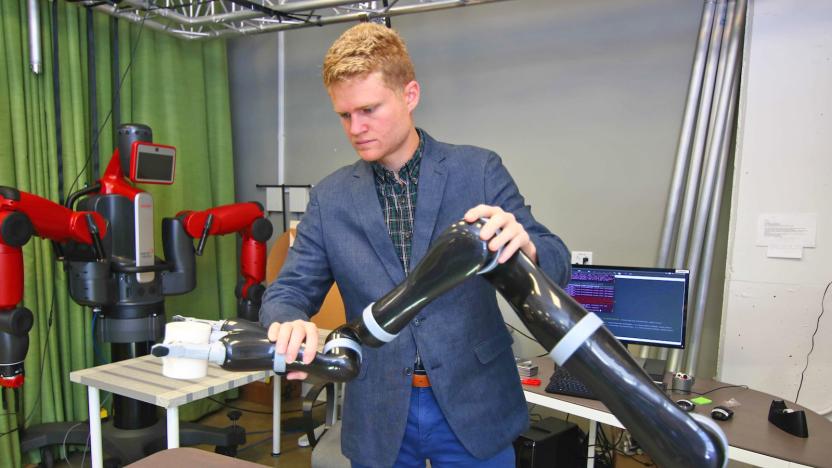impedance
Latest

Researchers develop a way to train robots with just a gentle nudge
Researchers at Rice University have developed a way to train robots with just a little push. Their method uses algorithms that allow robots to not only respond to a human's touch in the moment, but alter their trajectory based on that physical input. "Here the robot has a plan, or desired trajectory, which describes how the robot thinks it should perform the task," said graduate student Dylan Losey about the project. "We introduced a real-time algorithm that modified, or deformed, the robot's future desired trajectory."

Disney Research develops capacitive touch that detects multiple users through their fingertips (video)
Creating a truly multi-user, multi-touch display is a tricky prospect. How do you know who's who short of turning the screen into one giant fingerprint reader? Chris Harrison, Ivan Poupyrev and Munehiko Sato at Disney Research have suggested in a paper that fingerprinting on a capacitive touchscreen isn't far off -- it's just what we need to fingerprint that matters. Rather than look for physical ridges, the scientists' method sweeps through AC frequencies to find the exact electrical impedances of fingertips in contact with the screen. Different bodies, different clothes and even different shoes give everyone a unique signature that lets the screen identify specific people, even when they each have multiple fingers in play. The researchers propose that the technique would work well in collaborative workspaces, personalized devices and security, but let's not forget that this is Disney we're talking about: it's placing a strong emphasis on the prospects for shared screen gaming without the limitations we know today. While any practical use is still some distance away, it's easy to see future tablets and tables that are designed from the start to encourage a little socializing.

Smartphones for audiophiles: is the iPhone 5 more musical than its rivals?
Related reviews Apple iPhone 5 Samsung Galaxy S III HTC Sensation XE (first phone with Beats Audio) The love of audio. It's a dangerous condition, because every minute spent obsessing over headphones or specs or conflicting opinions is a minute not spent enjoying your favorite tracks or discovering new ones. That's why a review like this, which compares the iPhone 5 with rival phones based largely on acoustic qualities, runs a high risk of time-wastage -- no one really needs a cacophony of flowery words with no concrete conclusions. How to steer clear of the technological equivalent of a wine-tasting? By trying our damnedest to focus only on the more practical pros and cons of these top handsets, specifically from the POV of someone who listens to a lot of music on their phone. We're talking about someone who likely prefers high-bitrate recordings and who is ready to spend money on something better than the earbuds (or EarPods) that come in the box. In addition to testing Apple's new flagship we'll also look at the iPhone 4S, which is now a ton cheaper than it was a few weeks ago, as well as the Galaxy S III (both the global and the Sprint US version) plus the HTC One X (global and AT&T), and run them all through an audiophile obstacle course that goes right from purely subjective observations through to slightly more scientific tests as well as storage, OS and battery comparisons. There'll also be some consideration of the iPhone 4, Nokia Lumia 800 and PureView 808, although it'll be more condensed. And yes, we'll end up with an overall winner, but the research here is about more than that. Different phones may suit different people, depending on their priorities. Moreover, new handsets are just around the corner -- the Lumia 920, the Note II, the LG Optimus G and whatever other goodies the future undoubtedly holds -- and so it makes sense to have a bed of knowledge against which new entrants can be judged. Interested? Then let's get started.

Researchers use bioimpedance as a biometric, let health monitor devices know who you are
Wouldn't it be great if fitness and medical gadgets automatically knew who was wearing them? Researchers from Dartmouth have come up with a new way to provide health monitors just such an ability using a tiny electric current and a bioimpedance sensor. You see, each person's body provides a different amount of opposition to electrical current, so bioimpedance can be a unique biometric identifier. The researchers' idea is to create a bracelet that uses bioimpedance readings to recognize its wearer in a secure, unobtrusive manner and communicate that identity to other wearable devices. Using such a bracelet, "the devices discover each other's presence, recognize that they are on the same body (and transitively learn from the wrist device whose body), develop shared secrets from which to derive encryption keys, and establish reliable and secure communications." As opposed to other biometrics or password authentication, bioimpedance readings can be taken passively, which is much more appealing than remembering passcodes or scanning fingerprints and retinas. For now, the researchers have created an eight-electrode proof-of-concept bracelet, but its accuracy leaves something to be desired -- it correctly identifies its wearer only 80 to 90 percent of the time, whereas fingerprint recognition has a failure rate of less than 1 in 1,000. So, we're a ways off from bioimpedance-based security, but research is ongoing, and you can learn all about it at the source below.



